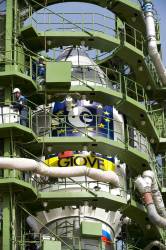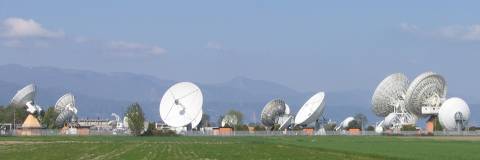 Close up view of the payload fairing of the Soyuz-Fregat launcher carrying ESA’s GIOVE-B satellite, on the launch pad in Baikonur, Kazakhstan, prior to the April 27, 2008, launch. ESA photo by S. Corvaja
Close up view of the payload fairing of the Soyuz-Fregat launcher carrying ESA’s GIOVE-B satellite, on the launch pad in Baikonur, Kazakhstan, prior to the April 27, 2008, launch. ESA photo by S. CorvajaA new generation of GNSS signals will become available soon as Europe’s second Galileo In-Orbit Validation Element satellite (GIOVE-B) reached orbit, following successful launch on Sunday (April 27) from the Baikonur cosmodrome in Kazakhstan.
Riding a Soyuz/Fregat launcher, the 500-kilogram (1,100-pound) spacecraft lifted off at 12:16 a.m. Central European Summer Time (CEST). The Fregat upper stage performed a series of maneuvers to reach a circular orbit at an altitude of about 23,200 kilometers inclined at 56 degrees to the equator. The two solar panels that generate electricity to power the spacecraft deployed correctly and were fully operational by 5:28 CEST.
The European space Agency (ESA) operational schedule called for Galileo signals at three L-band frequencies to begin transmitting within seven to eight hours after reaching orbit, according to Giuseppe Viriglio, ESA’s director of telecommunications and navigation.
A new generation of GNSS signals will become available soon as Europe’s second Galileo In-Orbit Validation Element satellite (GIOVE-B) reached orbit, following successful launch on Sunday (April 27) from the Baikonur cosmodrome in Kazakhstan.
Riding a Soyuz/Fregat launcher, the 500-kilogram (1,100-pound) spacecraft lifted off at 12:16 a.m. Central European Summer Time (CEST). The Fregat upper stage performed a series of maneuvers to reach a circular orbit at an altitude of about 23,200 kilometers inclined at 56 degrees to the equator. The two solar panels that generate electricity to power the spacecraft deployed correctly and were fully operational by 5:28 CEST.
The European space Agency (ESA) operational schedule called for Galileo signals at three L-band frequencies to begin transmitting within seven to eight hours after reaching orbit, according to Giuseppe Viriglio, ESA’s director of telecommunications and navigation.
These new signals will include Europe’s version of the multiplex binary offset carrier (MBOC) design that the European Union and the United States agreed will be broadcast in common on Galileo’s Open Service and the future GPS civil signal at the L1 frequency. The U.S. version of the MBOC will not be available until the first GPS III satellite is launched, currently projected for 2014.
Once the GIOVE-B spacecraft platform is fully commissioned, the navigation payload can be switched on. The rubidium and passive hydrogen maser clocks will be started first, followed by the navigation signal generator.
The final units to be turned on will be the transmit chain consisting of L-band solid-state power amplifiers that broadcast the Galileo signals to the Earth. First signal transmission is anticipated in the coming days and will be received and calibrated by In-Orbit Test (IOT) facilities deployed at ESA’s ground station in Redu (Belgium) and at Chilbolton Observatory in the UK.
A European industrial team led by Germany’s Astrium GmbH built GIOVE-B, with Thales Alenia Space performing integration and testing in Rome and EADS Astrium UK providing the navigation payload. The satellite is now under the control of Telespazio’s spacecraft operations center in Fucino, Italy, which has begun checking out the in-orbit operation of the satellite.
Like its predecessor GIOVE-A, the second Galileo satellite carries two small rubidium atomic clocks, each with a stability of 10 nanoseconds per day. But it also features an even more accurate payload: a passive hydrogen maser (PHM), with stability better than 1 nanosecond per day, the first of its kind ever to be launched into space.
On operational Galileo satellites that will begin launching within a few years, two PHMs will serve as primary onboard clocks, with the two rubidium clocks serving as back-up.
GIOVE-B also incorporates a radiation-monitoring payload to characterize the space environment at the altitude of the Galileo constellation, as well as a laser retroreflector to enable high-accuracy orbit determination using laser ranging.
Launch of the new spacecraft was delayed for more than a year following a catastrophic electrical short that occurred during testing in the Thales Alenia Space laboratory in the summer of 2006. A further delay from a December 2007 launch date stemmed from the absence of a suitable Soyuz rocket.
These delays, however, gave ESA the opportunity to add the MBOC signal to the navigation payload at the cost of a few million additional euros, according to Paul Verhoef, head of the Galileo Unit in the European Commission’s Directorate for Energy and Transportation.




